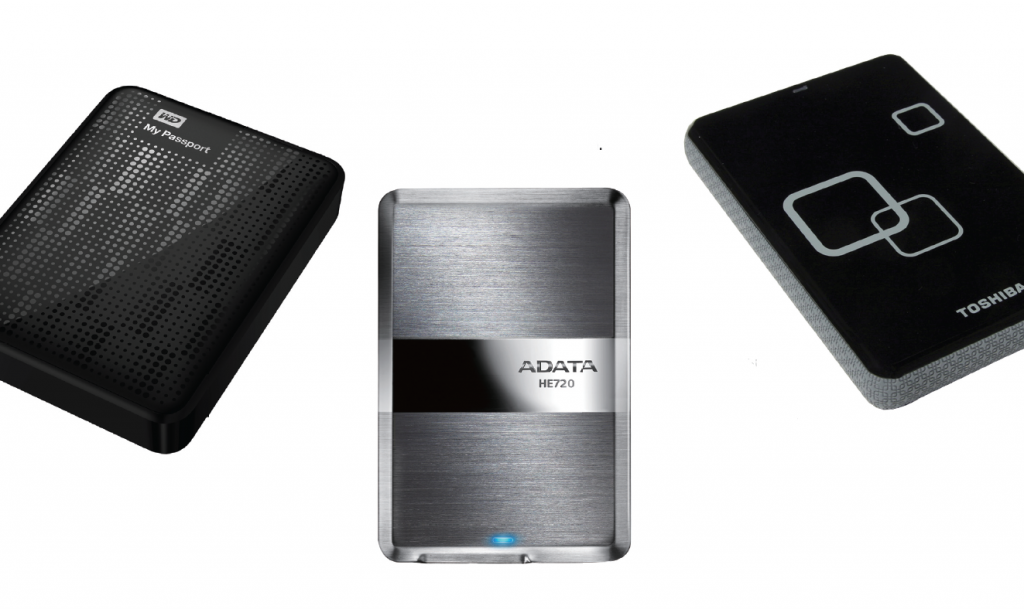
External Hard Drives: Which One is Right for You?
As we advance further into the digital age, the need for larger storage solutions has increased. Thankfully, external hard drives have stepped in to accommodate our ever-increasing amounts of data. External hard drives come in a myriad of capacities. Nowadays, you can purchase a 1 Terabyte hard drive for under $100. To put it into perspective, one terabyte can hold over 750,000 MP3s or photos, or 230 full-length movies.
Considering that external drives are ancillary to the internal system of your computer, you can hook up multiple external hard drives to your system. This opens up a number of possibilities on how to use your external drive: extra storage for your primary system; a back-up of your system files in case your computer bites the dust; or simply as a larger capacity storage solution to transport documents.
Should I stay or should I go?– Desktop vs. Portable
There are two different types of external hard drives: Desktop and Portable. Desktop drives have a standard 3.5-inch hard drive inside (what you would find in a desktop computer) and require a power adapter to make the drive run. Desktop drives are designed to be stationary; that is, they are commonly used as extra storage for desktop systems at home or at the office. Desktop drives see more heavy-duty projects and files compared to a portable drive, making them ideal for business and home use. Due to their increased capacity and speeds, many Desktop drives have built-in fans that will extend the life of your drive, protecting your important data for the long-haul. Although Desktop drives offer larger capacities, their need for an external power sources makes them not as convenient as Portable drives.
Portable hard drives are completely different beasts compared to their Desktop-stranded cousins. Like Desktop drives, Portable drives have the same 2.5-inch hard drive inside like you would find in a laptop computer. However, unlike Desktop drives, Portable drives do not need an external power source and are powered through your computer, making them optimal for people on-the-go. Able to support entire music libraries, enormous graphic and video files, and thousands of word documents, portable drives are ideal for college students and people who frequently travel.
Capacities
The highest capacity for a Desktop is currently 6TB. However, Seagate has been shipping out samples of their new 8 and 10 TB hard drives to enterprise customers, giving us hope that larger-capacity Desktop drives will be hitting the market soon. Portable drives max out at a significantly smaller 2TB, but even smaller capacities (320 GB, 500 GB, 1TB) are more popular and common.
A Solid State of Mind
Hard Disc Drive (HDD) -style external hard drives are more common, but Solid State Hard drives (SSDs) are slowly becoming more popular due to the common problems which arise with HDDs. SSDs only currently exist in smaller capacities (64-512 GB) due to their complexity. Solid state external hard drives are not as common compared to external HDDs due to their high price point; although SSDs generally have a longer life span than your standard spinning HDD, you’ll get more gigabytes-per-dollar by purchasing a larger capacity HDD. A standard USB 3.0 500 GB HDD will run you about $80, whereas a 256GB (almost half the capacity!) SSD will cost you about $400.
Interfaces
External drives have to connect to your system somehow, and every type of connector offers a different speed of transfer. USB 2.0/3.0 are standard, but other connectors such as FireWire, eSATA, and Thunderbolt are faster connectors. For the average consumer, USB 3.0 has beat out USB 2.0 as the preferred port; USB 3.0 provides faster transfer speeds compared to USB 2.0 and are more universal since all modern computers are fitted with USB ports. Some tablets and netbooks even have USB 2.0 ports built into them!
For Apple users, Thunderbolt connectors are becoming more standard. Although other manufacturers have yet to widely adopt the Thunderbolt interface, Apple has seen great success with it. Thunderbolt (formerly known as Light Peak) was initially designed as a faster optical link using fiber optics. Thunderbolt cables can not only power external hard drives, but also monitors and whole computers! Surprisingly, Apple’s innovation has helped boost Thunderbolt cables to be the fastest connectors with a transfer speed of up to 20GB per second. Some other manufacturers, such as Hewlett Packard, have tried to follow in Apple’s footsteps by putting thunderbolt cables as standard in their systems. However, because the Thunderbolt interface is expensive compared to USB 2.0/3.0 connectors, many companies are reluctant to add the Thunderbolt interface to their products.
The Bottom Line
Overall, there is a wide spectrum of different external hard drives available. Each kind offers different services, so picking the right external hard drive can be difficult. Color and design is usually one of the largest factors. If you’re going to be embarrassed about the look of your hard drive, you probably won’t use it as much. Personally, I have LaCie Rugged portable hard drive. It’s got an ugly orange bumper on it, which makes me less likely to take it out of the house for portable use. Warranty can also be a factor—be sure to research this before purchasing your new hard drive.
Useful, affordable, and convenient, external hard drives provide us with the much needed storage space we need in this expanding digital age. Which one is right for you?